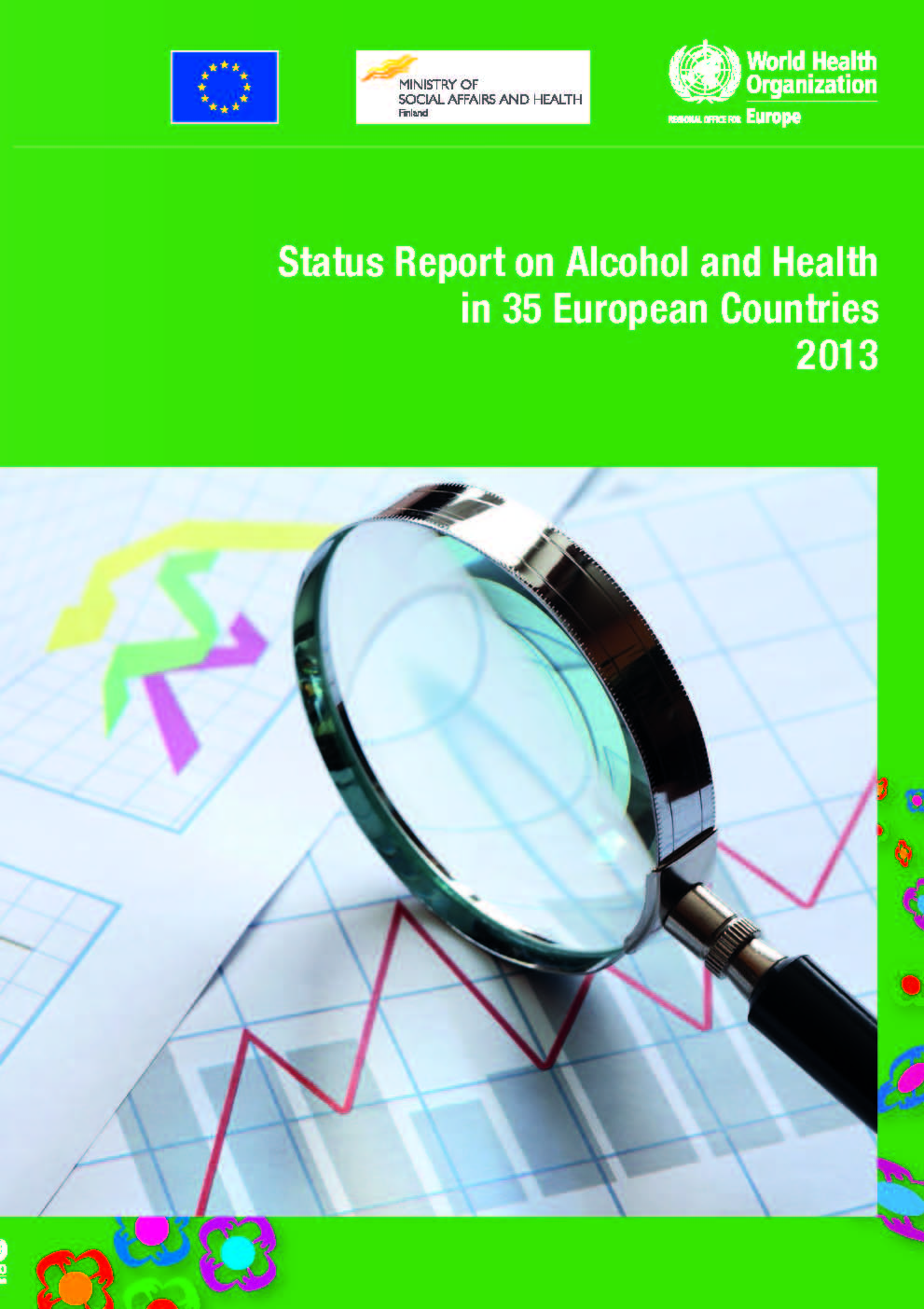Mongan, Deirdre
(2013)
Status report on alcohol and health in Europe.
Drugnet Ireland,
Issue 47, Autumn 2013,
pp. 15-16.
In 2012, the WHO Regional Office for Europe collected information on alcohol consumption and related harm, and countries’ policy responses to contribute to the Global Information System for Alcohol and Health. The resultant report presents a selection of the results for 35 countries – EU member states and candidate countries, and Norway and Switzerland.1

Alcohol consumption and related harm
The most recent data collected from the 35 countries show that adults aged 15 years and over consumed 9.4 litres of alcohol per capita in 2010. The corresponding figure for EU countries only was 10.2 litres. There was a marked decrease in recorded adult per capita alcohol consumption in the EU as a whole between 1990 and 2010. This was mainly due to a reduction in consumption in southern European countries (Cyprus, Greece, Italy, Malta, Portugal, and Spain) that started before 1990.
Alcohol has been established as a major risk factor for premature mortality in the EU, and the overall level of alcohol-attributable mortality in the EU is high, as measured by mortality due to the three most important alcohol-attributable causes of death, namely, cancers, liver cirrhosis and injuries. Alcohol-attributable mortality was highest in the central-eastern and eastern country group (Bulgaria, Croatia, Czech Republic, Estonia, Hungary, Latvia, Lithuania, Poland, Romania, Slovakia and Slovenia), where alcohol consumption is on the increase. According to the report: ‘A simple regression analysis indicates that the correlation between adult per capita consumption of alcohol and alcohol-attributable mortality is strong (R2 = 0.70), and that the number of alcohol-attributable deaths increases exponentially as adult per capita consumption increases’ (p.7).
Alcohol consumption can result in many types of harm to people other than the drinker, which are difficult to quantify. This report estimates only the alcohol-attributable harm to others due to motor vehicle accidents and assaults. In the EU, Croatia and Switzerland in 2010, 1.04 deaths per 100,000 people (0.56 deaths per 100,000 women and 1.55 deaths per 100,000 men) were caused by alcohol-attributable motor vehicle accidents and assaults. This represents 9.9% of all alcohol-attributable injury deaths (30.2% of all alcohol-attributable injuries for women and 7.9% of all alcohol-attributable injuries for men). The burden of alcohol-attributable harm to others was greatest in the central-eastern and eastern country group, with 2.23 deaths per 100,000 people (1.20 deaths per 100,000 women and 3.36 deaths per 100,000 men).
European survey on alcohol and health 2012
Part 2 of the report presents the results of the EC/WHO survey on alcohol and health, carried out in 2012. The survey was sent to the national WHO focal points for alcohol policy in each country, to be completed in consultation with various national experts. Respondents were asked to rate whether action in various policy areas had been strengthened, weakened or remained unchanged over the past five years.
The areas in which the most countries (excluding the five EU candidate countries) reported positive developments were public awareness-raising (23 countries), drink-driving policies and countermeasures (22 countries), and monitoring and alcohol research (21 countries). Two thirds of the countries (20) reported strengthened action in controlling the availability of alcohol. However, two of the most effective policy measures have seen fewer positive policy developments in recent years, with the majority of countries reporting that policies to control the affordability of alcohol (17 countries) and policies to regulate the marketing of alcoholic beverages (19 countries) had either been weakened or remained unchanged. At the end of 2011, 23 countries had a written national policy on alcohol; six of the remaining seven were in the process of developing such a policy.
According to the report:
All 30 countries reported that excise duty is levied on beer and spirits. However, just over one third of the countries do not have an excise duty on wine. Only four countries reported that the level of excise duty is regularly adjusted for inflation. … A few countries reported using price measures other than taxation. At the end of 2011, Germany and Sweden prohibited below-cost selling (selling for a price less than the production cost), and Finland and Sweden prohibited volume discounts (such as two-for-one offers) (p.20).
Major steps or milestones in the development of policy
Alcohol policy timelines for each country were also reported. These timelines are a summary of the major steps taken or milestones reached in each country in the development of policy and action to reduce alcohol-related harm during the period 2006–2012. The milestones reported by Ireland include:
· the establishment of the Government Alcohol Advisory Group in 2007 to examine the law governing the sale and consumption of alcohol;
· The Intoxicating Liquor Act 2008;
· the establishment of a code of practice on the display and sale of alcohol in mixed trading premises in 2008;
· the enactment of the Road Traffic Acts 2010 and 2011, which reduced the maximum legal blood alcohol concentration (BAC) when driving a vehicle, and made provision for the mandatory testing of drivers at collision sites and in hospital following a road traffic collision; and
· the publication of Steering group report on a national substance misuse strategy in 2012, which is a roadmap for the future direction of policy to deal with the use and misuse of alcohol.
Conclusion
The report concludes:
In principle, all alcohol-attributable deaths are avoidable, and there are clear indications that policy measures can be implemented which could decrease alcohol-attributable mortality markedly in a relatively short period of time. The most important of these measures would be increased taxation, decreased availability, bans on advertising and marketing, and an increase in treatment rates for people with alcohol problems. (p.11)
1. World Health Organization (2013) Status report on alcohol and health in 35 European countries 2013. Copenhagen: WHO Regional Office for Europe. www.drugsandalcohol.ie/20017 